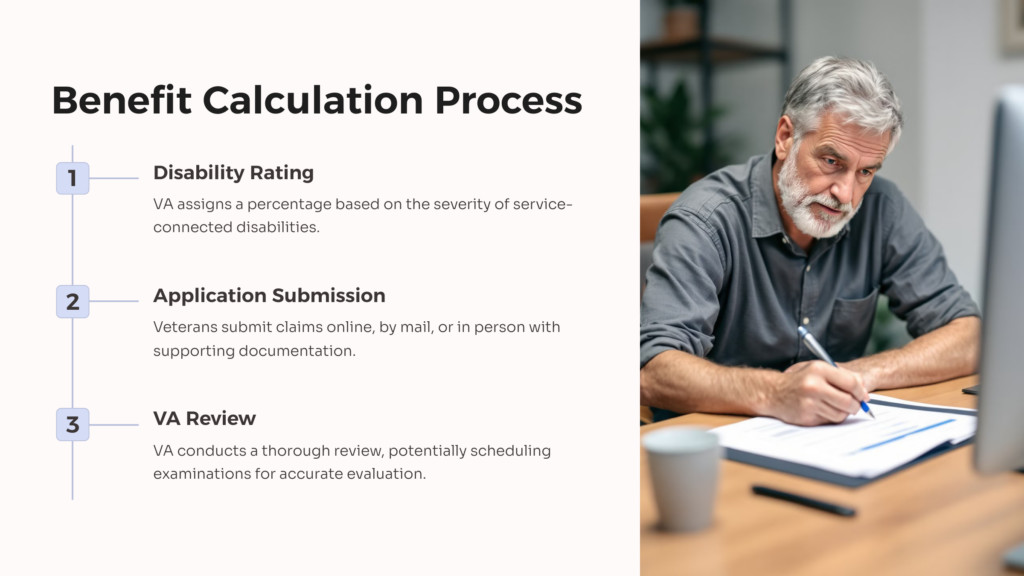Understanding the Veterans Affairs Disability 5 Year Rule
The VA Disability 5 Year Rule is a critical aspect of the VA benefits system for veterans, designed to ensure that those with service-connected disabilities receive the support they need.
It prevents the VA from decreasing a veteran’s disability rating, and thus their disability benefits once the rating and benefits have been in place for five years. This is the case unless the veteran’s condition has improved significantly.
The VA Disability 5 Year Rule aims to reflect the current status of a veteran’s disabilities accurately. However, understanding how it works is essential for veterans to navigate their benefits effectively.
Eligibility Criteria Under the VA Disability 5 Year Rule

To qualify for benefits under the VA Disability 5 Year Rule, veterans must meet specific requirements These requirements are crucial to understanding their eligibility for VA disability compensation. The requirements mostly focus on the nature of the disabilities veterans experience and when these disabilities occurred.
Service-Connected Disabilities
For a veteran to be eligible for benefits under the Veterans Affairs Disability 5 Year Rule, they should have a service connected disability. That means the disability or disabilities must stem directly from injuries, illnesses, or conditions that occurred or were aggravated during a veteran’s active military service. Essentially, the disability must be linked to the veteran’s time in service.
Establishing a service connection typically involves providing medical evidence to demonstrate the relationship between the disability and military service. This evidence may include medical records, reports from healthcare providers, and statements from the veteran detailing the onset or aggravation of the disability during their time in the military.
The VA evaluates the severity of these disabilities using the VA Disability Rating Schedule. This schedule assigns percentages to different conditions based on their impact on a veteran’s ability to work and perform daily activities. This VA rating ultimately determines the level of compensation the veteran receives.
Timeframes
Another critical aspect of eligibility under the VA 5 Year Rule is the timeframe within which disabilities are evaluated and reevaluated. Within the first five years following a veteran’s discharge from active duty, the VA has the authority to review and potentially adjust the veteran’s disability rating based on changes in their condition.
This five-year timeframe is significant as it allows the VA to ensure that disability ratings accurately reflect veterans’ current circumstances. During this period, veterans may undergo periodic evaluations, known as reexaminations, to assess the status of their disabilities and any changes that may have occurred since their initial evaluation.
It’s essential to recognize that while the VA has the authority to review disability ratings within the first five years, not all veterans will experience a reduction in their benefits. Many veterans maintain stable disability ratings throughout this period, while others may see an increase in their ratings if their conditions worsen over time.
That means some veterans might receive increased benefits while others will receive the same, or potentially, less depending on the status of their disability and how it affects their ability to work and perform daily living activities.
By meeting the requirements related to service-connected disabilities and timeframes, veterans can establish their eligibility for disability benefits under the VA Disability 5 Year Rule. Understanding these criteria is essential for navigating the claims process effectively and ensuring that veterans receive the compensation and support they deserve for their service-related disabilities.
Calculation of Benefits Under the VA Disability 5 Year Rule

Once a veteran establishes eligibility for disability benefits under the VA Disability 5 Year Rule, the next step involves the calculation of the benefits they are entitled to receive. The VA uses a specific process to determine the amount of disability benefits a veteran will receive. To do this they take various factors related to their service-connected disabilities and their impact on the veteran’s life into account.
Disability Rating
The cornerstone of benefit calculation under the VA Disability 5 Year Rule is the veteran’s disability rating. This rating, expressed as a percentage, reflects the severity of the veteran’s service-connected disabilities and determines the amount of compensation they are entitled to receive. The VA assigns disability ratings based on the extent to which a veteran’s disabilities impair their ability to perform activities of daily living and work.
To establish these ratings, the VA considers medical evidence provided by the veteran, including medical records, examination reports, and statements from healthcare providers. The Disability Rating Schedule outlines specific criteria for evaluating the severity of various disabilities, assigning percentages based on the degree of impairment they cause.
Application Process
Veterans seeking disability benefits under the VA Disability 5 Year Rule must complete an application process to initiate their claim. This process typically involves submitting a formal application, known as a claim for disability compensation, to the VA. Veterans may submit their claims online through the VA’s eBenefits portal, by mail, or in person at a VA regional office.
Along with the application, veterans are required to provide supporting documentation. This includes medical records, treatment history, and statements from healthcare providers detailing their service-connected disabilities. The documentation serves as evidence to support the veteran’s claim and helps the VA assess the severity of their disabilities.
Once the VA receives the application and supporting documentation, it conducts a thorough review to determine the veteran’s eligibility for disability benefits. This review may involve scheduling examinations or obtaining additional medical evidence to evaluate the veteran’s disabilities accurately.
Factors Considered
During the calculation of disability benefits under the VA Disability 5 Year Rule, the VA considers several factors beyond the veteran’s disability rating. These factors may include the veteran’s marital status, number of dependents, and any additional special circumstances that may impact their eligibility for benefits.
For example, veterans with dependents may be entitled to receive additional compensation, known as dependency and indemnity compensation (DIC), to support their family members. Additionally, veterans with severe disabilities may qualify for special monthly compensation (SMC) to address specific needs related to their disabilities.
The VA also takes into account any applicable laws, regulations, and precedent-setting court decisions that may impact the calculation of disability benefits for veterans under the VA Disability 5 Year Rule.
Overall, the calculation of disability benefits under the VA Disability 5 Year Rule is a complex process that takes into account various factors related to the veteran’s service-connected disabilities and their impact on their life. By understanding the factors considered and the application process, veterans can navigate the claims process more effectively and ensure they receive the compensation they deserve for their service-related disabilities.
Exceptions and Special Circumstances

While the VA Disability 5 Year Rule is strict, there are exceptions for certain circumstances. For example, veterans with severe disabilities may receive protection from future examinations, ensuring that their benefits do not decrease in the future.
Additionally, certain service-related conditions, such as PTSD, may qualify for expedited processing of claims. Understanding these exceptions is crucial for veterans navigating the benefits system.
Navigating Changes Over Time
The VA Disability 5 Year Rule may undergo changes or updates over time. These changes can stem from legislative amendments, procedural updates, or shifts in VA policy.
Veterans must stay informed about these changes to ensure they receive the benefits they deserve. Regularly checking the VA’s website or consulting with veterans’ service organizations can help veterans stay updated on any developments.
Maximizing Benefits Within the 5 Year Rule Framework

Despite the constraints of the VA Disability 5 Year Rule, there are strategies veterans can employ to maximize their benefits. This includes seeking assistance from veterans’ service organizations, such as the American Legion, which can provide advocacy and support throughout the claims process.
Additionally, veterans should maintain regular communication with their VA representatives to ensure their benefits accurately reflect their current circumstances.
Appeals and Disputes
In some cases, veterans may disagree with decisions made regarding their benefits eligibility under the VA Disability 5 Year Rule. In such instances, they have the right to appeal these decisions through the VA’s appeals process.
However, navigating this process can be complex, and veterans may benefit from seeking assistance from legal experts or veterans’ service organizations to increase their chances of a successful appeal.
Comparisons with Other VA Disability Rules
Understanding the VA Disability 5 Year Rule in comparison with other VA disability rules is essential for veterans to fully understand which benefits they might be eligible for.
One crucial comparison is with the VA’s 20 Year Rule. This rule provides additional protections for veterans who have maintained a disability rating for 20 years or more.
Unlike the 5 Year Rule, which focuses on reviewing disability ratings periodically within the first five years, the 20 Year Rule offers stability and protection for veterans with long-standing disabilities.
Under the 20 Year Rule, veterans who have held a total disability rating for at least 20 years are considered to have a “protected rating.” This means that their disability rating cannot be reduced by the VA unless the VA can prove fraud or material misrepresentation in the original claim.
This protection provides veterans with peace of mind and ensures that their benefits remain stable over time, regardless of changes in their medical condition.
While the VA Disability 5 Year Rule serves the purpose of ensuring that disability ratings accurately reflect veterans’ current circumstances, the 20 Year Rule offers a higher level of security and stability for veterans with long-term disabilities. By understanding the differences between these rules, veterans can better advocate for their rights and navigate the benefits system more effectively.
Impact on Family and Dependents
The VA Disability 5 Year Rule not only affects veterans but also has implications for their families and dependents.
Understanding these implications is crucial for veterans as they plan for their futures and consider how their disabilities may impact their loved ones. One of the most significant considerations is the availability of benefits for surviving spouses and dependents following the veteran’s death.
Surviving spouses of veterans may be eligible for Dependency and Indemnity Compensation (DIC) if the veteran’s death was service-connected They may also be eligible if the veteran’s death occurred while the veteran was receiving VA compensation for total disability for at least 10 years immediately preceding death, or for at least 5 years from the date of discharge from active duty immediately preceding death. Dependency and Indemnity Compensation provides monthly financial support to eligible surviving spouses and their dependent children.
Understanding these benefits can provide crucial support for veterans’ families during challenging times.
Future Outlook and Considerations
Looking ahead, it’s essential for veterans to consider potential future developments or changes regarding the VA Disability 5 Year Rule. This includes staying informed about proposed legislation that may impact veterans’ benefits and planning for the long term accordingly.
By staying proactive and engaged with the benefits system, veterans can ensure they receive the support they need well into the future.
The VA Disability 5 Year Rule is a vital aspect of the benefits system for veterans, ensuring that their disability ratings accurately reflect their current circumstances.
By understanding the eligibility criteria, exceptions, and strategies for maximizing benefits, veterans can navigate the system effectively and access the support they deserve. It’s crucial for veterans to stay informed about changes to the rule and plan for the long term to secure their benefits and support their families.
For more information on VA Disability benefits and navigating the VA Disability 5 Year Rule, visit Allveteran today.
 AllVeteran.com Advisors
AllVeteran.com Advisors
With expertise spanning local, state, and federal benefit programs, our team is dedicated to guiding individuals towards the perfect program tailored to their unique circumstances.











